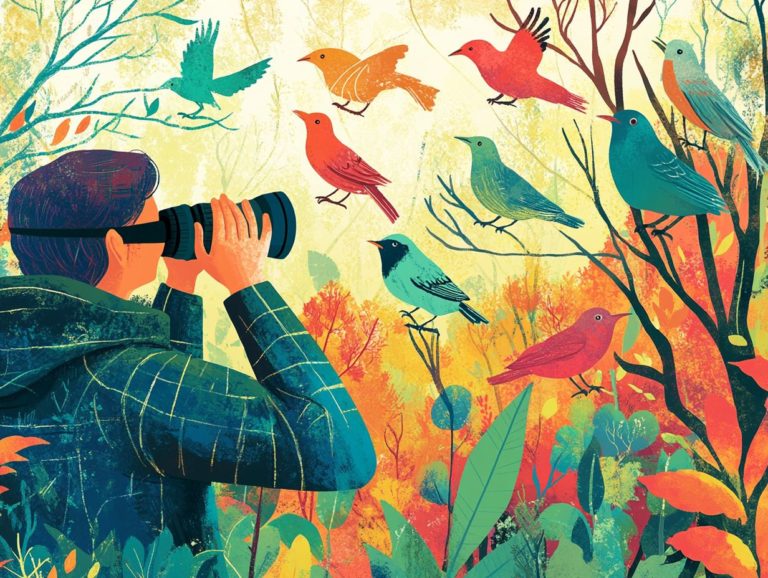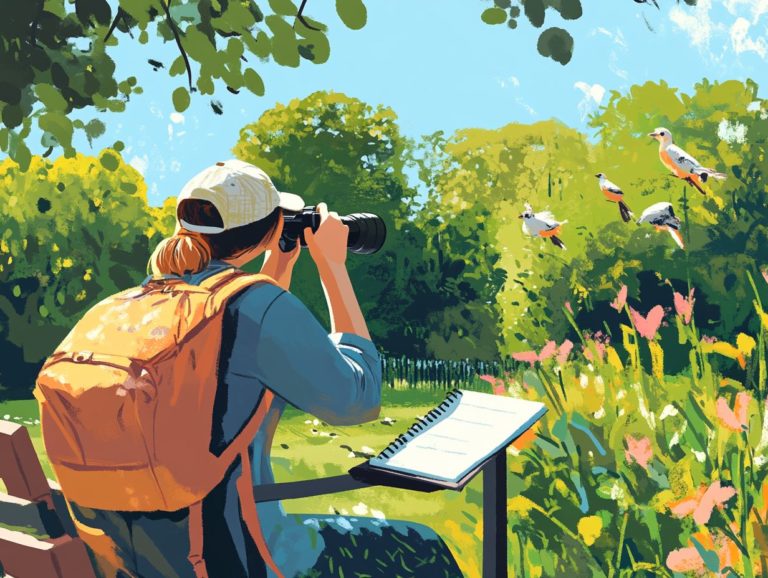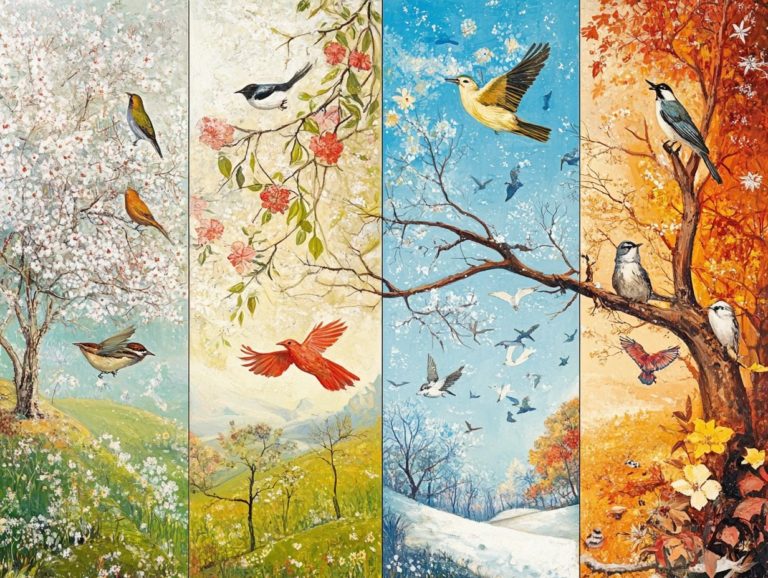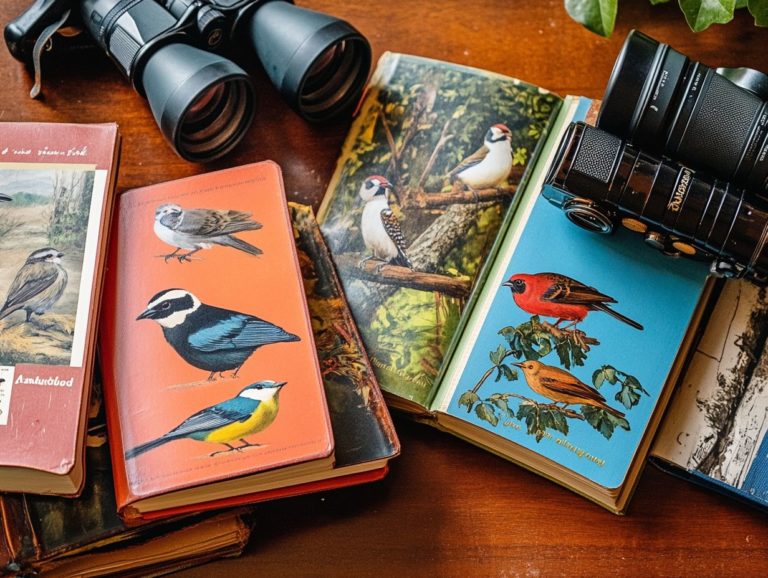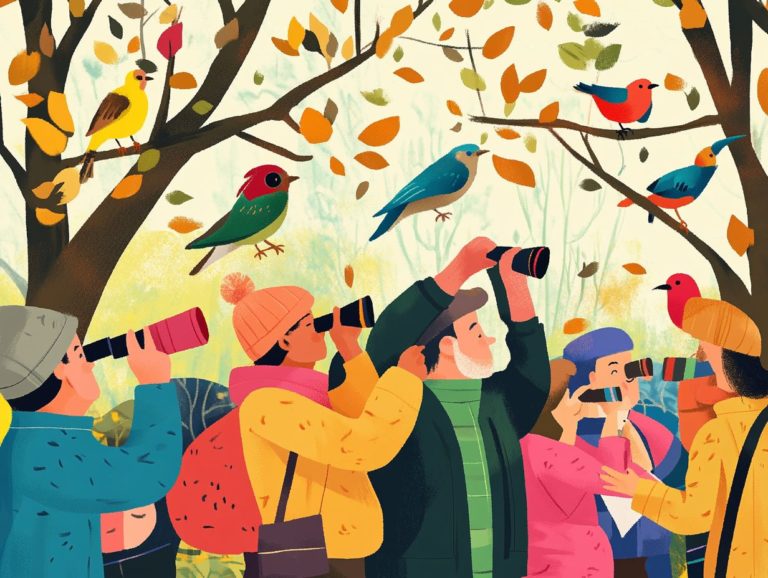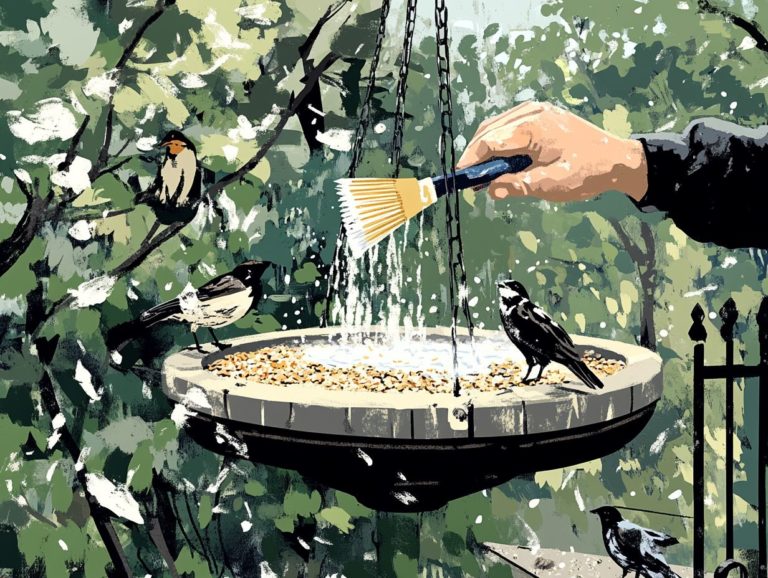When is the Best Season for Bird Watching?
Bird watching goes beyond just a fun hobby; it s your ticket to experiencing nature in vibrant ways. It reveals the fascinating lives of birds that come out at night and those that migrate with the seasons.
Whether you re an experienced bird watcher or just curious about our feathered friends, diving into this activity offers numerous benefits for your physical and mental well-being.
This article will walk you through the best times for bird watching, including spring and fall migration, highlight key factors to consider, and provide helpful tips to enhance your experience.
Get ready to discover the joys of observing birds throughout the year!
Contents
- Discover the Key Takeaways!
- Benefits of Bird Watching
- Factors to Consider for Bird Watching
- Best Seasons for Bird Watching
- Tips for Successful Bird Watching
- Frequently Asked Questions
- When is the Best Season for Bird Watching?
- What makes spring a good season for bird watching?
- Why is fall also a good season for bird watching?
- Are there any specific regions or habitats that are best for bird watching?
- Is there a particular time of day that is best for bird watching?
- What can I do to attract more birds to my backyard for bird watching?
Discover the Key Takeaways!
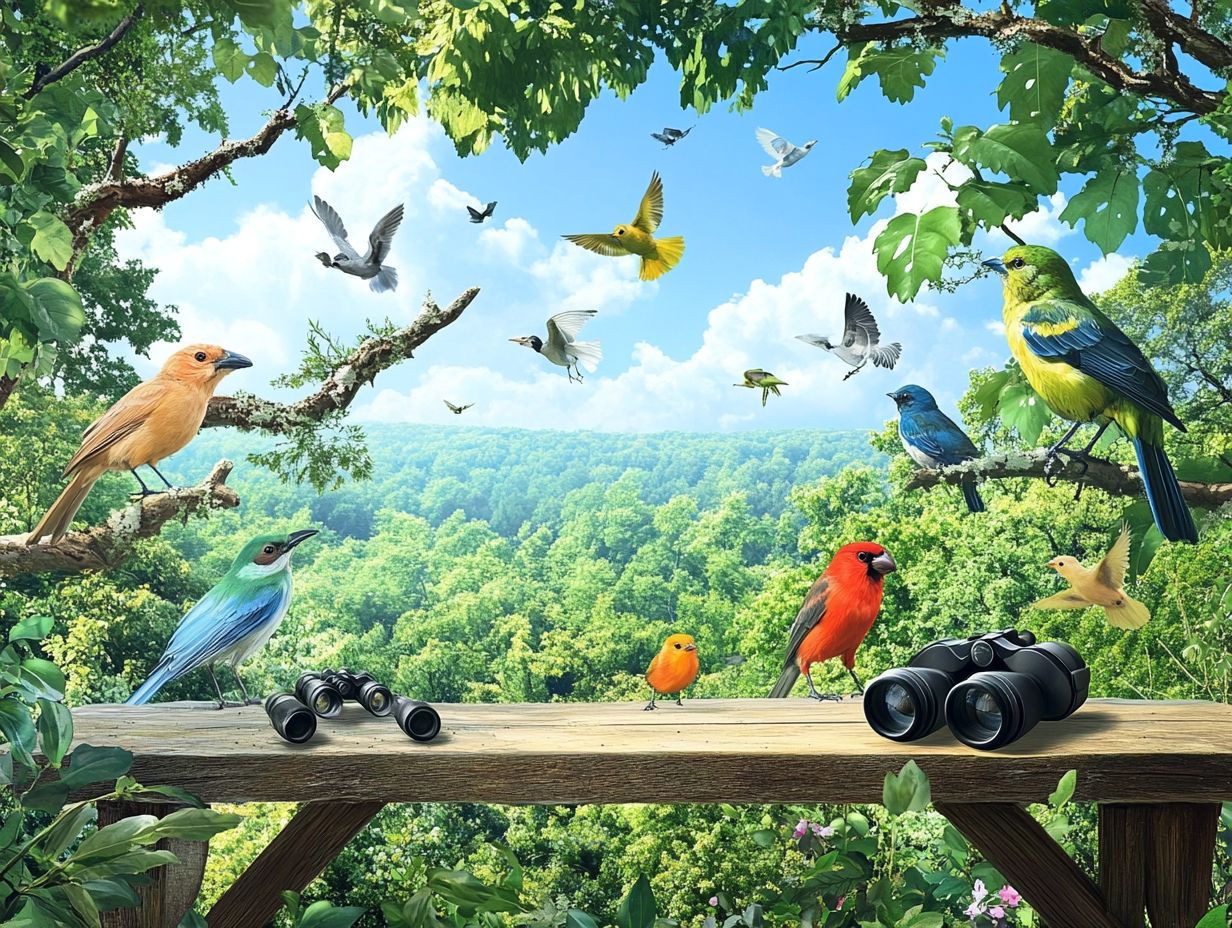
- Spring is the best time for bird watching as many species return from their winter migration, making it an ideal season for sightings, especially during April events.
- Summer is also a fantastic season for bird watching, with birds being most active and showcasing their unique behaviors.
- Fall is another great time for bird watchers, marking the start of migration for many species and offering a chance to see a variety of birds passing through.
What is Bird Watching?
Bird watching, often called birding, invites you to observe birds in their natural habitats. This rewarding hobby connects you with nature and offers insights into bird behavior.
Local bird watchers often use binoculars and field guides to explore the rich diversity of bird life while participating in community activities that enhance their experiences.
This pastime has a rich history, tracing back to early bird enthusiasts of the 19th century who paved the way for modern birding. Today, bird watchers eagerly await each season change, looking forward to the arrival of migratory species that grace their surroundings.
Birders frequently come together in birding clubs, sharing tips, stories, and the excitement of spotting new species. Innovative apps now help enthusiasts document sightings and share experiences effortlessly.
The joy of observing birds not only fosters a sense of community but also enhances your understanding of the environment, supporting conservation efforts that benefit both birds and their habitats.
Benefits of Bird Watching
Bird watching offers many benefits, from boosting your physical health through enjoyable outdoor activities to providing significant mental health rewards.
Connecting with nature brings a sense of calm and mindfulness, allowing you to experience enriching moments that nurture both your body and mind.
Physical and Mental Health Benefits
Bird watching is a delightful way to boost your physical well-being while enhancing your mental health. It provides a therapeutic escape from daily stress, immersing you in nature’s beauty.
As you embark on walks or hikes, you may notice improvements in your cardiovascular health, with your heart and lungs working together as you explore diverse terrains. Beyond physical benefits, the tranquility of nature helps reduce anxiety and fosters mindfulness, allowing for a deeper connection with your surroundings.
Participating in birding activities cultivates a vibrant community of fellow enthusiasts who share your love for feathered friends. This camaraderie enriches your experiences and provides essential emotional support, reinforcing the idea that nature can be a true sanctuary for both body and mind.
Factors to Consider for Bird Watching
When planning a birdwatching trip, consider several key factors. Think about the optimal timing for your adventure and how seasonal changes impact bird behavior.
Selecting the best locations for the time of year and local migration patterns can significantly enhance your birdwatching experience, allowing you to witness the bird world in all its splendor.
Are you ready to start your bird-watching journey? Get outside, enjoy nature, and see what you can spot!
Location and Time of Year
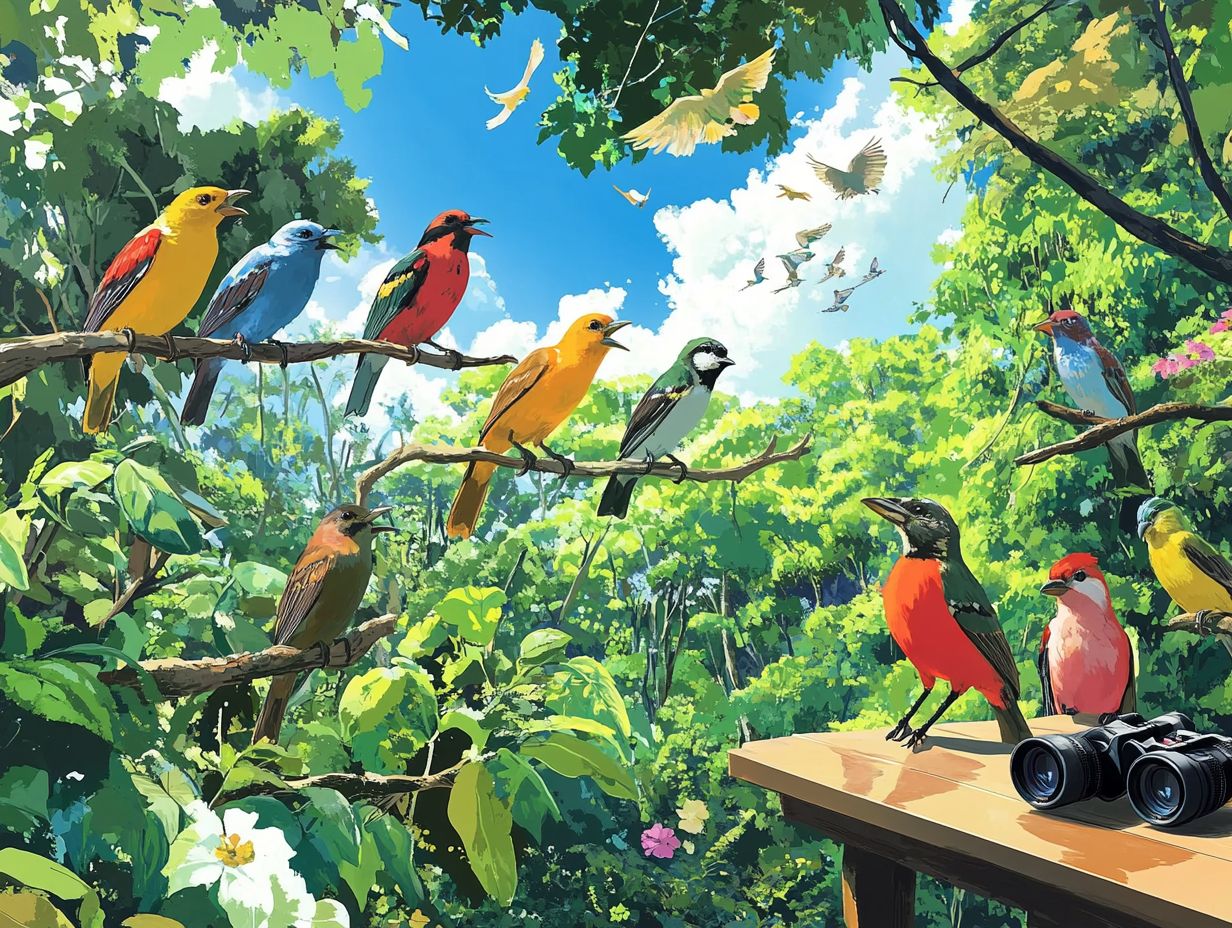
Choosing the right spot and time of year can greatly affect your birdwatching success. Different bird species show unique behaviors and migration patterns in each season.
This insight allows you, the thoughtful birdwatcher, to capitalize on specific hotspots celebrated for attracting a diverse array of bird life. For example, wetlands in the spring present a treasure trove of nesting opportunities. Coastal regions transform into vibrant hubs during the fall migrations. By grasping how seasonal changes influence the availability of food and nesting sites, you can significantly elevate your birdwatching experience.
As spring unfolds, the thrill of witnessing migratory species return to their breeding grounds reaches its zenith. It makes spring the best time for eager enthusiasts to go birding. You can refine your strategies, opting for early morning excursions to capture those most energetic hours.
During autumn, shift your focus to locations known for their spectacular flocks as birds embark on their southward journeys. This offers a breathtaking display of nature’s rhythm.
Best Seasons for Bird Watching
Each season presents you with special birdwatching moments. In spring, you’ll witness vibrant migrations that paint the skies with life.
Summer is full of birdwatching activities. You can watch feeding birds nurture their young and learn about their unique behaviors.
As fall arrives, marvel at the incredible journeys of various species on their migratory paths.
Winter provides a peaceful escape where you can observe winter birds in their serene habitats. Each encounter is a moment of quiet beauty.
Spring
Spring is an exciting season for birdwatching. Many birds return from winter, showcasing their vibrant colors and distinct calls.
You can witness the American Robin, the Eastern Warbler, and the Blue Jay. Many species engage in captivating nesting rituals and mating displays, making spring an ideal time for keen observation.
To truly enrich your birdwatching experience, familiarize yourself with the unique characteristics and behaviors of these migratory marvels, such as bird calls and songs. Strategies like keeping a field guide at your side can significantly enhance your ability to track migration patterns and specific sightings, allowing for a more informed and engaging experience in the field.
Summer
During the summer months, immerse yourself in a wealth of birdwatching activities. Watch feeding birds nurture their young and gain a fascinating understanding of their behaviors and interactions.
By setting up bird feeders in your backyard, you ll attract a delightful array of local species that thrive in the warmth, such as vibrant finches and playful chickadees. Watching their nesting behaviors can be particularly rewarding; you ll notice how many birds are busily seeking food for their chicks and becoming increasingly vocal.
Summer presents a unique opportunity to witness captivating feeding patterns. Observe how parent birds forage and how fledglings learn to find food on their own.
Having a field guide on hand will elevate your experience, allowing you to easily identify the various local species that frequent your garden during these sun-soaked months.
Fall
Fall is a fantastic time to see bird migration. Countless species head to their winter homes, offering great chances for observation and identification.
As the air cools and days shorten, many birds start their journeys. Among them are the striking monarch butterflies and colorful warblers, each with unique patterns and colors. Visit local parks, wetlands, or coastal areas during peak migration for the best experience.
When you watch, look for features like feather patterns, unique calls, and flight styles. Bring your binoculars and field guides; they re essential for appreciating this remarkable sight while respecting the birds’ homes.
Winter
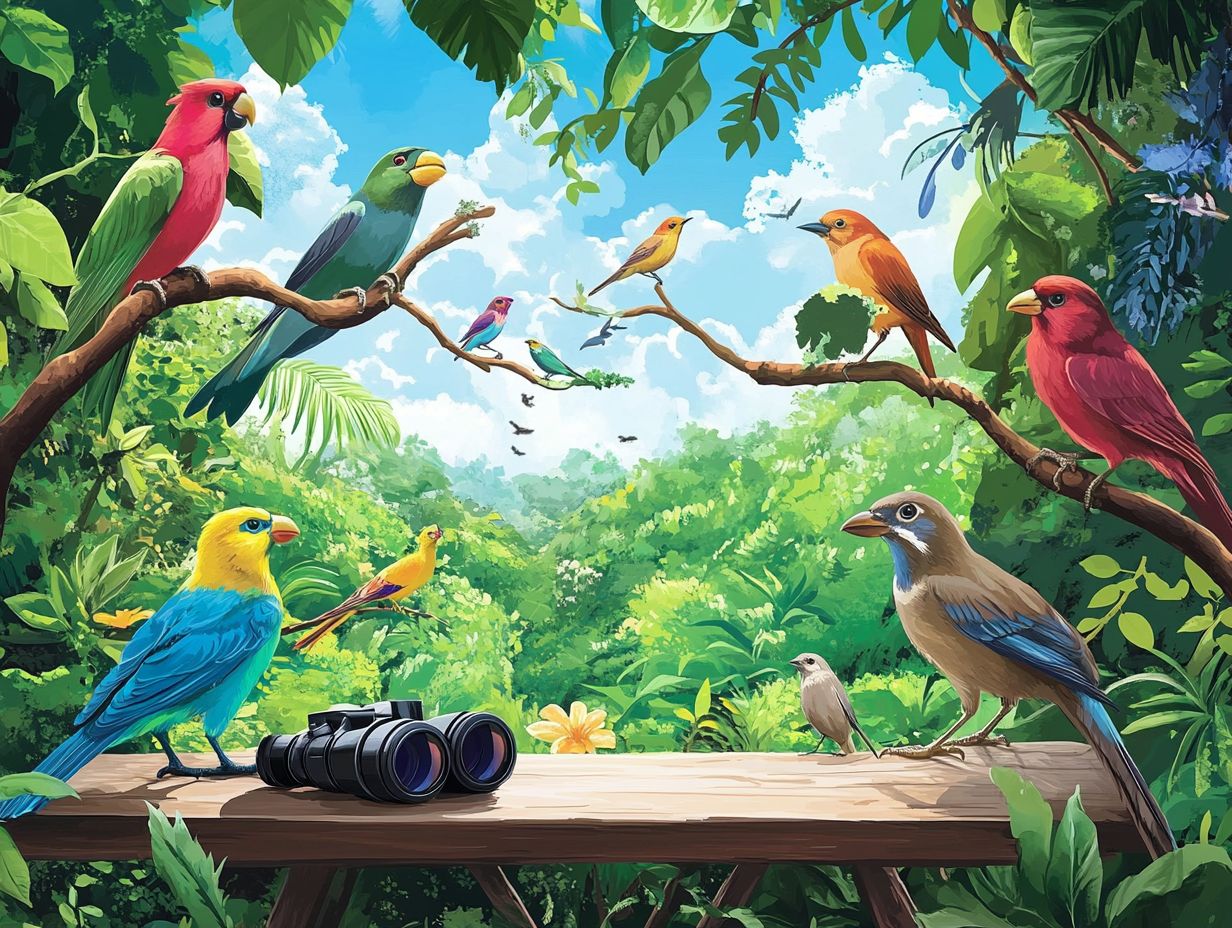
Winter birdwatching is an exciting adventure filled with challenges and amazing rewards! You get to observe winter birds that have adapted to the cold.
Birds like chickadees, cardinals, and jays have thick feathers and change their behavior to thrive in the cold. Familiarize yourself with local habitats, as you ll often find these birds at feeders or nestled in trees and shrubs.
The winter conditions will test your patience and persistence. Dress in layers, pack hot drinks, and find a sheltered spot to shield yourself from the winds. With the right preparation, every outing can reveal the stunning beauty of winter birds and how they survive the chill.
Tips for Successful Bird Watching
To elevate your birdwatching, consider various tips and techniques. Invest in quality binoculars to enhance your viewing experience.
Learn to interpret bird calls and songs; this knowledge deepens your connection to the bird world. Techniques to refine your observational skills will help you appreciate the subtle details of bird behavior.
Equipment and Techniques
Having the right equipment is crucial for successful birdwatching. Good binoculars are essential for spotting the details in feathers and behavior that might otherwise be missed.
Plus, keep some trusted bird books or mobile apps handy to boost your identification skills. These resources provide visuals, sounds, and descriptions for a richer understanding of birds.
Combine this knowledge with techniques like active listening and patience whether you re in a local park or the wilderness. This approach will greatly enrich your experience and aid in identifying diverse species.
Final Thoughts and Recommendations
Bird watching transcends mere hobby status; it s a fantastic way to make a difference in conservation efforts and support the birding community. As you set personal birding goals and share your experiences, you become part of something larger.
Engaging with fellow enthusiasts allows you to deepen your appreciation for birds. You actively participate in initiatives that aim to preserve their habitats. Community involvement creates networks of support and knowledge, where you can learn from others and collaborate on meaningful conservation projects.
Joining local birding clubs opens doors to organized events and educational programs, enhancing your journey. These shared experiences not only enrich your insights but also instill a sense of responsibility for protecting our feathered friends.
Continued learning and participation are essential. Every contribution you make from observing behavior to advocating for preservation significantly impacts the sustainability of our natural world.
Frequently Asked Questions
When is the Best Season for Bird Watching?
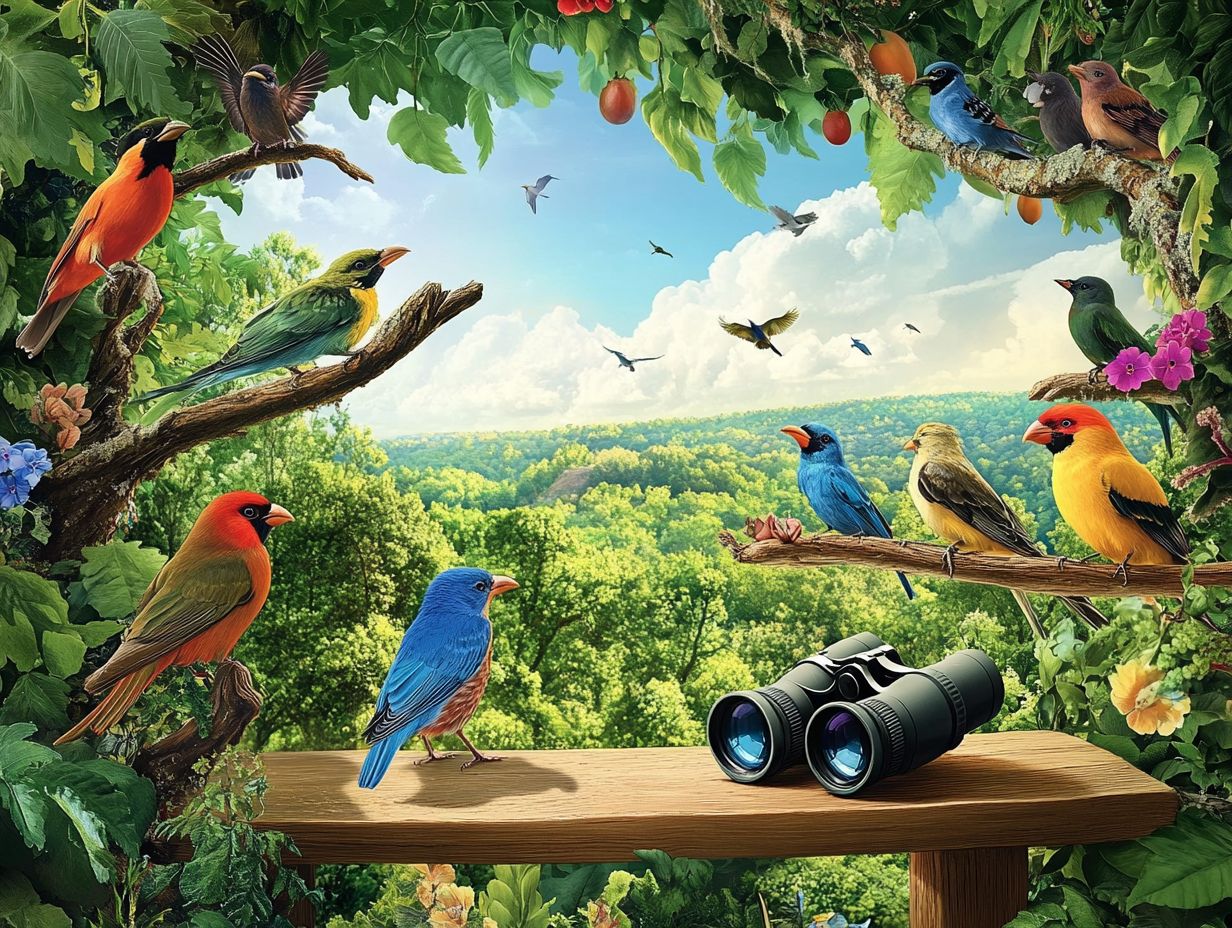
The best season for bird watching varies depending on your location and the type of birds you want to see. Generally, spring and fall are considered the best seasons for bird watching.
What makes spring a good season for bird watching?
During spring, many birds are migrating back to their breeding grounds and are more active and visible. This is also the time when birds are busy building nests and raising their young, making it an exciting time for bird watchers.
Why is fall also a good season for bird watching?
In the fall, many birds are preparing for their long migration journey. This means you can observe a wide variety of bird species as they pass through your area. It’s also a great time to see birds in their stunning fall plumage.
Are there any specific regions or habitats that are best for bird watching?
Yes, certain regions and habitats are known for their high bird diversity and activity. Coastal regions, wetlands, and forests are popular places for bird watching. It’s best to research the specific birds you want to see and their preferred habitats.
Is there a particular time of day that is best for bird watching?
The early morning and late afternoon are considered the best times for bird watching. This is when birds are most active and vocal, making them easier to spot and identify. However, some species may also be active during midday.
What can I do to attract more birds to my backyard for bird watching?
Providing food, water, and shelter can help attract a variety of birds to your backyard. Planting native plants and creating a bird-friendly environment can also make your backyard more appealing to birds. Keep in mind that it may take some time for birds to discover and visit your backyard, so be patient.
Join a local birding club today and start your journey in bird watching!

